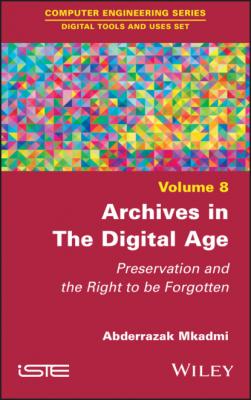Archives in the Digital Age. Abderrazak Mkadmi
Чтение книги онлайн.
Читать онлайн книгу Archives in the Digital Age - Abderrazak Mkadmi страница 5
 style="font-size:15px;"> 215
207
style="font-size:15px;"> 215
207
216 208
217 209
218 210
219 211
220 212
221 213
222 214
223 215
224 216
225 217
226 218
227 219
228 220
229 221
230 223
Digital Tools and Uses Set
coordinated by
Imad Saleh
Volume 8
Archives in The Digital Age
Preservation and the Right to be Forgotten
Abderrazak Mkadmi
First published 2021 in Great Britain and the United States by ISTE Ltd and John Wiley & Sons, Inc.
Apart from any fair dealing for the purposes of research or private study, or criticism or review, as permitted under the Copyright, Designs and Patents Act 1988, this publication may only be reproduced, stored or transmitted, in any form or by any means, with the prior permission in writing of the publishers, or in the case of reprographic reproduction in accordance with the terms and licenses issued by the CLA. Enquiries concerning reproduction outside these terms should be sent to the publishers at the undermentioned address:
ISTE Ltd
27-37 St George’s Road
London SW19 4EU
UK
John Wiley & Sons, Inc.
111 River Street
Hoboken, NJ 07030
USA
© ISTE Ltd 2021
The rights of Abderrazak Mkadmi to be identified as the author of this work have been asserted by him in accordance with the Copyright, Designs and Patents Act 1988.
Library of Congress Control Number: 2021930486
British Library Cataloguing-in-Publication Data
A CIP record for this book is available from the British Library
ISBN 978-1-78630-676-0
Preface
Digital archiving is not storing data, but rather keeping it in an intelligent way in order to be able to exploit it over time while maintaining its integrity and authenticity. With the rapid transformations caused by the use of computer tools, several types of documents are nowadays stored with and served by archive services: email, databases, digital photographs, digital audiovisual content, exchanges on social media, etc. We are thus witnessing an evolution of the concepts and practices in the human and social sciences toward what we call “digital humanities”. This has led to the development of new tools and applications that promote access to and use of archives. At the same time, there has been an explosion of documents and information emanating from, inter alia, mobile technologies, social media, online transactions and connected sensors, which must be collected, preserved and disseminated. Commonly known today as Big Data, these megadata use very powerful technologies, which tend to store everything and for a long period of time. However, this concern to preserve everything in the name of the right to remember is confronted with another right, that of being forgotten. This right is often linked to the freedom of individuals who are condemned to living without privacy and freedom by being faced with the mistakes of their past.
This book attempts to provide a general overview of the complexity of the evolution of the concept of digital archives through three dimensions: human and social, technical and legal. It first presents the contours and necessary elements of its definitions, as well as the methods and strategies of digital archiving while presenting the normative landscape governing the field. The book then details the changes undergone by archives in the digital humanities in terms of content, media, preservation and access. It then tries to show the extent to which the arrival of Big Data has changed the work of archivists. The challenge is to process more data, at a lower cost and in a shorter timeframe. In this context, blockchain as a decentralized and distributed registry is presented as a complementary solution to digital archiving. Finally, special attention will be given to the legal and technical dimensions of archive processing through the right to be forgotten.
January 2021
Introduction
Today, archives represent, in almost all the meanings of different countries, all documents, whatever their date, nature or medium, produced or received by any individual or legal entity in the course of their administrative activities. These documents are kept for their information, proof and/or testimony value. The term “archives“ also refers to the place where these documents are kept (building or conservation premises). In addition to being evidence and guarantors of rights, archives can also be objects of historical and scientific research. As a result, the majority of states have developed archive services open to the public and legal texts that oblige administrations to hand over to these services those documents that no longer have administrative, financial and/or legal value and that have historical and/or scientific value.
Archives can be public, i.e. created by public bodies or entrusted with a public service mission, such as public establishments, consular services and ministerial officers. They can also be privately owned by individuals, families, associations or companies and are donated to the public archives through donations, deposits, legacies and other means. The distinction between these two categories is not always easy to make, because of the overlap that there may be in the documents of a politician, for example, between official functions and private activities arising from his or her responsibility to a party